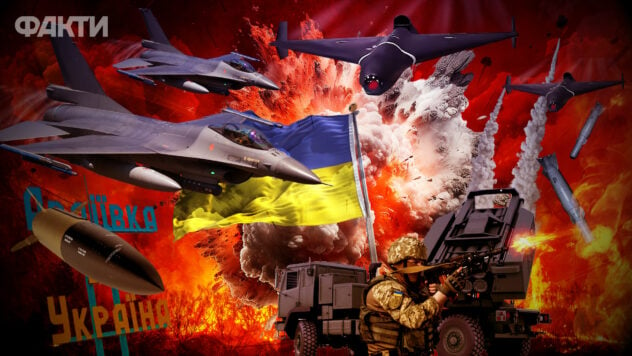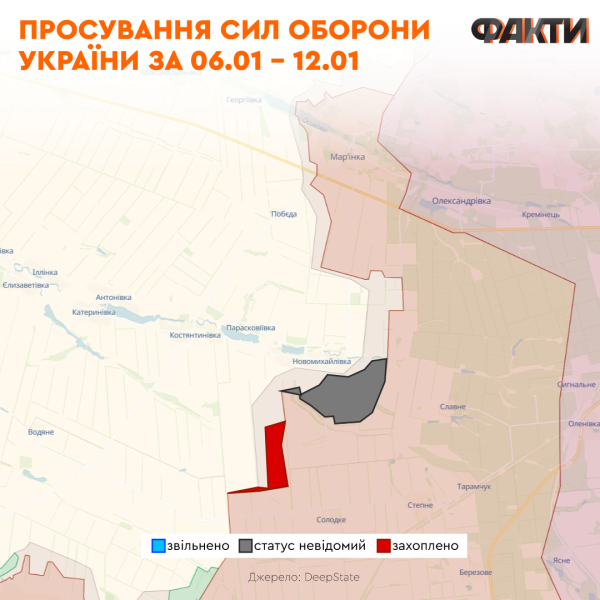
Another week has passed of the heroic resistance of the Ukrainian people against the Russian occupiers. It was no less intense than the previous one. The situation at the front remains consistently difficult.
The occupiers continue to advance on three directions — Kupyansky, Limansky and Bakhmutsky. Meanwhile, Ukrainian special services are intensifying operations behind enemy lines.
About the enemy’s new tactics, the use of modernized Shahed-238 drones and whether the Russian occupiers will be able to capture the Lugansk and Donetsk regions before the elections in the Russian Federation — read in the material Facts ICTV.
Now watching
Kupyansk direction
Liman direction
Avdeevskoe direction
Use of Shahed-238 by the occupiers
Explosions behind enemy lines
Do you want to relax? Come to Facti.GAMES!
Sunak’s visit to Kyiv
Kupyanskoe direction
The Russian military continues to advance in the Kupyansk direction.
They do not give up attempts to capture Sinkovka, with the goal of blocking Kupyansk itself.
– As far as I know, this enemy’s intention ended unsuccessfully for him. In this sense, the enemy is greatly hampered by the fact that the Ukrainian Armed Forces hold several important plantings east of the village, from where they destroy any enemy attempts to overcome the open area between the forest and Sinkovka with more or less significant forces, says Konstantin Mashovets, coordinator of the Information Resistance group.
Limansk direction
According to the commander of the Ground Forces of the Ukrainian Armed Forces in the Liman direction, the enemy is carrying out offensive actions in order to push Ukrainian troops beyond the Black Stallion River and is carrying out intense artillery shelling.
In addition, the enemy is moving additional assault companies from Russian territory to this area and is training new assault troops in base camps. Also trying to clear mine advance routes.
One of the areas where the enemy’s main efforts are concentrated remains Serebryansky forestry.
– “There are unsuccessful attempts to attack our positions with the support of armored vehicles in the directions of Dibrova, Torskoye and Yampol,” noted Syrsky.
Avdeevskoe direction
On the northern front of the Avdeevsky area of defense of the Ukrainian Armed Forces, the enemy also had some success. The advanced units of the enemy's 114th Motorized Rifle Brigade, with the support of the 15th Motorized Rifle Brigade, managed to advance southeast of the Terrikon position in the direction of the Brevno area and fire and rescue unit No. 13.

Map: our website
– It seems that the Armed Forces of Ukraine have completely left the village. Stepovoye, and the enemy command finally began the practical implementation of one of the options to bypass Avdeevsky Koksokhim. Namely, bypassing the plant from the east and southeast, through Brevno and the Avdeevskaya motor depot,” Mashovets wrote in his review.
Use by occupiers Shahed-238
The media reported that a new Iranian jet drone, Shahed-238, was allegedly shot down over the Ukrainian sky. The Air Force has not yet confirmed this information.
Kamikaze drone Shahed-238 — this is a further development of the Shahed-131 and Shahed-136 series.
The presentation of Shahed-238 was held in November 2023, even then it attracted attention not only with the presence of a jet engine that can accelerate to 500-600 km, but also with the use of several types of target coordinators &# 8212; homing heads (GOS).
– 500-600 kilometers — This is not supersonic speed; we cannot say that this will somehow radically change the effectiveness of our air defense systems. 500-600 km — this is the speed at which attack aircraft fly, for example, the same Su-25. Therefore, we can, of course, fight these drones better if we have modern systems, including anti-aircraft artillery systems, like Skynex, or advanced radar systems that will help receive information about these drones,” the director of New told Facts ICTV in an exclusive interview Geopolitics Research Network, military expert Mikhail Samus.
Read more about the situation at the front, the enemy’s plans for Donetsk and Lugansk, as well as what the Ukrainian Armed Forces need in order to move further along the front — watch in the exclusive interview of ICTV Facts with the director of the New Geopolitics Research Network and military expert Mikhail Samus in the video below.
Explosions behind enemy lines
Last week, a series of explosions occurred in the occupied territories and in Russia itself.
On the morning of January 13, when the Russians launched massive missile attacks on Ukraine, explosions also occurred in the still occupied Berdyansk, Zaporozhye region. It is known that smoke rose in the area of the commandant’s office and from Primorskaya Square. Explosions in the port area did not subside for a long time.
On the same day it was loud in Mariupol, Donetsk region. The invaders' barracks were hit. The impact occurred in the area of the third depot of the trolleybus and transport department, not far from the plant named after. Ilyich in the Kalmiussky district.
And a Russian missile landed in the Krasnodar region of the Russian Federation. In connection with this, local authorities even blocked the road.
Sunak’s visit to Kyiv
On January 12, British Prime Minister Rishi Sunak arrived in Kyiv. They, together with Ukrainian President Vladimir Zelensky, signed a security agreement.
The agreement provides for guarantees of financial, military and other types of support.
The parties decided to strengthen cooperation and partnership based on common interests in protecting international law and order, peace and the protection of fundamental human rights and freedoms.
The document does not contain any commitment for Britain to enter the war on the side of Ukraine if Russia attacks again. Duration of the bilateral agreement — 10 years.

